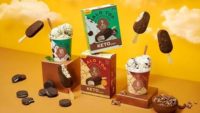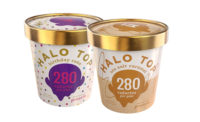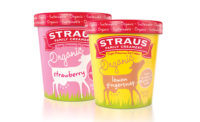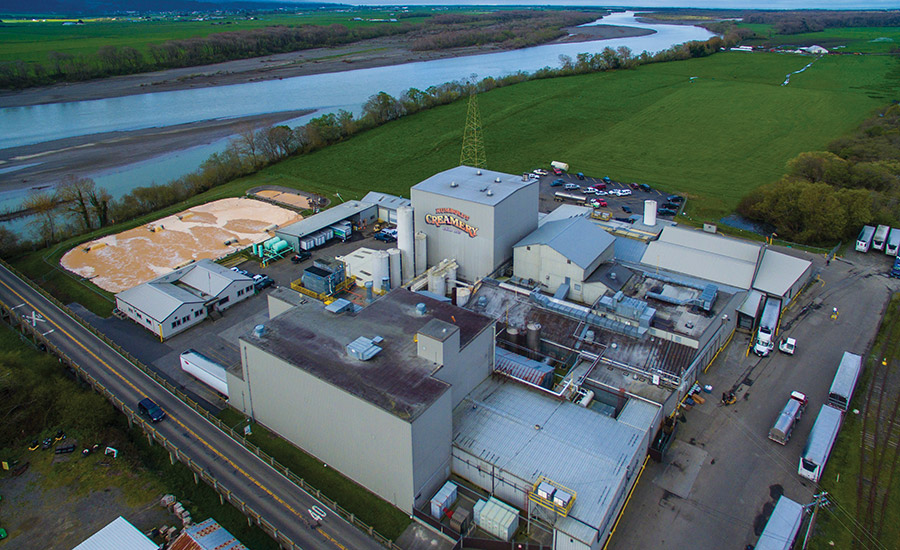Walmart's welcome mat
Organic ice cream from Humboldt Creamery is available nationwide
Consumers looking for foods with a clean label and ‘pure’ attributes often choose organic products. California’s Humboldt Creamery, located in prime dairy country, is serving those consumers with fluid products, ice cream and powders.

Humboldt Creamery is flying high. Its organic ice cream brand is available nationwide thanks to a deal with Walmart. Organic powders are popular with food processors and confectioners.

A new marketing campaign emphasizes the purity and simplicity of organic dairy products made by Humboldt Creamery.

Mike Callihan (center) is the plant manager at Humboldt Creamery, Fortuna, Calif. He’s surrounded by (from left) Travis Victorine, JoAnn Comalli, Tami Schleef, and Jesse Chittenden.

Paper half-gallons are conveyed to an automatic boxer and palletizer. Note the use of “Humboldt Proud” on the side panel. The marketing campaign supports foods and goods made in Humboldt County, Calif.

Drying is usually done in the evening when utility rates are lower. In the morning, the dried milk powders are packaged into 25-kilogram or 50-pound bags. Large totes are also used.

In the control room of the powder plant, Mike Callihan explains how milk is condensed and dried.






Humboldt County, California, is a great place to operate an organic dairy farm. The mild temperatures and ample annual rainfall allow cows to be in pasture 200 days or more a year. The county is roughly bounded by the Shasta-Trinity National Forest on the east and Pacific Ocean on the west. Warmed by the ocean currents, Eureka (the county seat) enjoys average temperatures ranging from 41 F (in December and January) to 64 F (in August and September).
On the other hand, the county might not be the first choice to build a dairy processing plant. There are not a lot of consumers in Humboldt County (population about 135,000) and the closest big cities are San Francisco and Sacramento, each about 270 miles away. The narrow roads, lined by redwood trees, restrict the size of tractor-trailers that can deliver supplies in the county.
But, in fact, there is a dairy here. Humboldt Creamery, located on the banks of the Eel River in Fortuna, dates to 1929 when it was founded as a dairy cooperative. Today, the processing facility aims to become a major player in organic dairy products. A recently signed deal with Walmart will put Humboldt Creamery organic ice cream in 3,200 stores nationwide.
“We think we could be a significant player on the [organic] ice cream side nationally,” said Frank Otis, CEO of Crystal Creamery, the parent company based in Modesto.
The company already has global reach. Conventional ice cream made in Humboldt for a private label client is sold in the United States, Europe and Asia. Organic fluid milk is sold under the Humboldt label and it is co-packed for national brands. Conventional and organic powders are sold to food processors and used in confectionery products.
Crystal Creamery bought Humboldt Creamery in 2009. The parent company is investing in the Humboldt brand to make it a national leader in organic dairy products. (The Crystal brand is used on conventional products.) Part of the marketing campaign plays off the small-town roots of the company. The remoteness of Humboldt County is an asset.
“Almost all the dairying in our area is located around a river,” said Humboldt Creamery Plant Manager Mike Callihan. He reeled off the names: Eel, Van Duzen, Mad, Smith and Elk.
For thousands of years, the rivers have flowed from the mountains and deposited soil and minerals in the valleys where dairy farmers pasture their cows. The grass and clover that grow in this rich soil affect the taste of the milk. When wine makers refer to soil, topography and climate, they call it terroir. It’s an idea that Humboldt’s marketing department is running with.
Taking consumers back to nature
An advertising campaign in Sunset Magazine, Edible, Modern Farmer and Delicious Living promotes farmers and dairy cows. The message is “real cows, real place, real milk,” said Susan Backer, a partner in Inhouse Creative, the Healdsburg, Calif., firm handling the marketing for Humboldt Creamery.
“The whole positioning is geared toward the consumer who cares about the quality of the milk that they drink,” she said. “They just need it to be clean, simple, delicious and organic. But the treatment of the cows and the farmers is just paramount. This brand is sort of like this encapsulation of what consumers are looking for.”
The time is right for organic dairy. In 2015, sales of organic whole milk increased 9.4% and reduced-fat milk (2%) rose 9.7%, according to the U.S. Department of Agriculture. (Sales of all other organic fluid products decreased.) Organic food, as a whole, represents almost 5% of total U.S. food sales, according to the Organic Trade Association.
As Backer noted, younger consumers especially seek foods that are minimally processed and free of genetically engineered ingredients.
“The younger generation has a new set of demands. As much as possible, they try to incorporate organic into their lives. It’s just a whole system of drinking something that’s not only good for you but it’s also good for the land, good for those who work the land and for the animals,” Backer said.
In 2009, Crystal Creamery (then called Foster Farms Dairy), bought Humboldt Creamery. The creamery was bankrupt, the result of loan fraud perpetrated by the former CEO, a long-time employee of the business. (He was convicted and served 30 months in prison.)
Crystal Creamery invested in deferred maintenance projects (like a new roof for the plant), bought new processing and packaging equipment, and put money into energy upgrades. As it stands today, the Humboldt operation is profitable in its own right, said Otis. He added, “That is a significant statement considering where the business was when we bought it.”
He noted just how important the Humboldt operation is to the entire Crystal operation when he said, “Humboldt is really top of mind for me. Growing our organic dairy business isn’t just a fad or hobby to me or others in the company. I probably have spent 25% to 30% of my time on the Humboldt reconfiguration and the relaunching of the Humboldt Creamery brand over the last 18 months or so because it’s really important to me. I don’t take any credit for our success at Humboldt as the success that we have enjoyed over the past couple of years is a total organization effort. However, I want the organization to know I’m fully committed to the Humboldt brand and organization. I believe that message is being sent by my willingness to roll up my sleeves and dive in with everyone else. It is a total team effort.”
What sets the Fortuna operation apart from many other fluid milk or ice cream processors is its ability to condense and dry milk, said Callihan, who has worked at the creamery since 1979. The facility operates as a balancing plant, converting milk into condensed milk or powders when the demand for fluid product slackens. In late February, he took Dairy Foods on a tour of the plant.
The tour starts at milk receiving
The plant employs about 100 area residents who work 8- to 10-hour shifts. Milk arrives every day at the two receiving stations, capable of handling four trucks at a time. There are receiving lines and silos dedicated to conventional and organic milk. Sugar arrives in liquid form and is pumped into a silo.
While full-size milk tankers can navigate the highways leading to the facility, larger tractor-trailers have a problem negotiating the roads because of redwood trees that grow right up to the shoulder. Road-widening projects have been shot down by the public. So finished product is trucked to various distribution or storage centers where loads are consolidated on larger trailers and transported to customers.
The plant has three high-temperature/short-time pasteurizers; one each in the fluid, powder and ice cream processing areas. The HT/ST units in the fluid and ice cream plants are batched systems.
“We set them up as batched systems because we needed the ability to either produce very small batches or do multiple batches to make very large batches,” Callihan explained. “We had customers on both ends of the spectrum. That gave us some flexibility within the facility.”
Fluid milk is packaged four days a week in two shifts, with four hours devoted to clean-in-place and sanitation. The California Department of Food and Agriculture and the federal Food and Drug Administration have jurisdiction over the plant. The plant has an enforcement rating of 98 on the most recent Interstate Milk Shippers list.
The milk is packaged in two formats: paper half-gallon cartons and plastic gallon jugs. The jugs are blow-molded in Modesto. A new half-gallon extended-shelf-life filler is scheduled to be installed in June. The plant processes Humboldt brand milk and co-packs store brands. (The Modesto plant also bottles organic milk.)
The filled packages are conveyed to an automated boxer and palletizer that builds pallets. The boxer is a new labor-saving and ergonomic investment. It builds a corrugated box around the packages (instead of the packages being picked up and placed in a preformed box). The pallets are moved into the cold room to await pickup along with hand-cased half-gallons and gallons.
“When we’re making organic, then we’ll start about six at night,” Callihan said. “We’ll have the trucks backed up to the doors. We’ve got trucks heading that way (southern California and central California) all night. Then we finish up with conventional.”
The milk crates will be delivered to local retailers. The pallets, destined for the Central Valley, are on a one-way trip. They won’t return to the creamery. Humboldt buys new pallets for outbound shipments.
Two rooms for ice cream production
The plant has a library of 35 to 40 mixes that can be used to manufacture 400 products. The creamery makes ice cream four to six days a week, depending on the time of year. It runs two shifts (totaling 20 hours, with four hours for clean-in-place).
Humboldt makes ice cream on three filling lines in two production rooms. One room has a 1.25-quart (40-ounce) filler making scrounds of organic product under the Humboldt brand. Humboldt recently installed a new filler on this side. The other room makes conventional ice cream for private label customers as well as Crystal’s McColl economy brand. Here, there are two lines that fill 64-ounce paper scrounds, 5-quart plastic pails and 3-gallon paper cans. The cans (destined for foodservice customers) are made onsite.
The freezers and fruit feeders in both production rooms are from the same manufacturer. This simplifies maintenance, parts inventory and training, Callihan said.
The 1.25-quart package has an integrated safety seal in the lid. The 64-ounce scrounds (made for a private label customer) pass through a machine that applies a safety seal around the lid and container. After passing through a metal detector, these packages are conveyed to a wrap-around boxer that was specifically built for the customer, who sells a box of two half-gallon packages.
After filling, the packages are sent to freezers for hardening. Each ice cream production room has its own blast freezer, where temperatures are -30 F. Then the creamery builds pallets of ice cream, wraps them in plastic, applies a bar-coded “license plate” and moves them to a holding area.
Every hour packages are pulled off the line for testing in the onsite lab. The lab also performs a daily cutting of the previous day’s production to look at attributes like the distribution of sauces and inclusions. Lab personnel are trained in sensory evaluation of fluid, powder and ice cream products. They perform organoleptic tests on the ice cream.
“Consistency to us is the key,” Callihan said. “It’s looking at the product and saying, ‘It’s the same as it was yesterday, as it is tomorrow, and it will be the next day.’”
Condensing and drying milk
The powder plant can run 24-7, depending on the milk flow. Condensed milk is used by the ice cream plant. One long-time powder customer is a chocolate company.
“We make the loads to order,” Callihan said. “A customer may have a specific analysis that they’re looking for. We can do whole milk powder, instantized nonfat dry milk, some low-spore and a variety of different products on the nonfat side.”
In a typical production run, the plant will dry and evaporate during the night (when energy costs are lower), storing the powder in hoppers. The powders are bagged during the day. The drying plant has a mechanical vapor recompression (MVR) evaporator.
Pasteurized product is passed over the raw product in a double-tube heat exchanger. The equipment recompresses the steam that is in the milk to evaporate the product, Callihan explained. Evaporation occurs in the 135 F range. Callihan described this as a “very gentle, low-heat process” that creates the desired flavor profile requested by customers.
For drying, the creamery uses a rotary atomizer.
“We have two-stage compact dryers so we do most of our drying in the main chamber,” Callihan said. “From there, we’ll drop into a stationary fluid bed where we do our final drying. The two-stage concept gives you a little more control over moisture because you’re doing a second drying phase. It gives you a little more flexibility from a product standpoint. We can either do whole milk or the instantized products that you don’t see on typical operations.”
To make the instantized product, the fines coming out of the cyclone and the bag house are blown back up into the system and are reintroduced into the wet product.
A heat recovery system, with water on one side and hot air on the other, is very energy-efficient. Though common in Europe, the Humboldt creamery was the first in the United States to have a two-stage compact dryer, Callihan said.
Finished dry product is loaded into bulk totes weighing about 2,000 pounds or filled in 25-kilogram and 50-pound bags. Almost all of the product is sold domestically. Organic powders are packaged in white bags, the result of listening to a customer who wanted its employees to have a visual cue that would distinguish the contents as organic. Conventional milk powders are packaged in brown bags.
“Our breadth of products is larger than what you would see in a lot of different companies,” he said. “In our ice cream facility, I use all fresh ingredients because I have them available to me every day. I have condensed cream in both organic and conventional on a daily basis. I’m not using powder in my formulation. I have products that are not available to some [processors] that don’t have a drying operation or setup like we do.”
Upgrades and maintenance of the plant
One of the first investments Foster Farms Dairy made after it bought the Humboldt plant was to upgrade all of the freon units “because milk is so temperature-sensitive,” Callihan said.
This year Humboldt completed a refrigeration technology update to control the ammonia refrigeration system. The system looks at the production needs, then chooses the proper compressor. Variable frequency drives on the motors make operating equipment more energy efficient.
The plant earned rebates from the utility company, lowering the payback period to less than three years. The investment also saved 1 million kilowatts a year. All of the lighting in the plant and office was converted to LED lighting by December 2015.
As for natural resources, the plant draws water from its own wells, not from the municipal system. It has its own wastewater system, too. There is a two-meg diesel generator that can provide 80% of the plant’s needs in the event of an emergency. Floods, wind storms and earthquakes are real possibilities. The plant sits on the banks of the Eel River.
Employees, training and food safety
In the dairy lab, technicians test raw milk for quality (like somatic cell counts) and components (like fats and solids). The lab also performs in-process and finished product testing. Pathogen testing is done off-site by a third-party lab.
The way the plant is set up (to accommodate small batches) allows it to act as a pilot plant, running 400-gallon tests.
“It’s more like a test facility. We can do some R&D here on site, because of the size of batches we can make,” Callihan said. “We have an ability to make almost like boutique-type creations. But then on the same hand, we can generate larger batches by making multiple batches and doing large runs. We’re looking in that direction for the fluid operation and also looking at the other operations, say the ice-cream, looking at unique flavors or unique ideas out there that we think might work for us, as a facility.”
Otis said the Humboldt team developed ice cream flavors for a large club-store client. It is also developing a nonalcoholic ice cream that tastes like beer.
Plant management listens to customers and is preparing itself to take advantage of shifting consumer attitudes about food. The company has performed non-GMO project verification for most of its products on the fluid and on the industrial side.
The plant is SQF Level 3 certified. Working toward that certification made the employees look differently at the facility because it puts a structure around the quality systems.
“We have a document register that has over 800 documents. It’s a much more methodical way of looking at quality and looking at your systems and then validating your systems,” Callihan said.
Suppliers are qualified through a vendor approval process that includes food safety items, employee safety programs and even social responsibility programs. The corporate QA team in Modesto also audits vendors.
Managers lead new hires through a one-day course on food safety and employee safety. All employees take monthly courses on all of the pre-requisite programs within SQF. Questions and answers about food safety play on a television monitor in the lunchroom so that when employees are on break, they can stay updated. Training programs are delivered on kiosks.
The meaning of ‘sustainable’
When Callihan uses the word “sustainable,” he is talking about more than water, energy and packaging. He said he wants the creamery to sustain communities. That includes the dairy farmers, local ingredient suppliers and creamery employees. Humboldt sells powder to a local chocolate company. “If we could bring that back into our facility [as a dairy foods ingredient], then it’s a full-circle product,” he said.
“We’re looking at trying to develop and make a sustainable business that allows the dairymen to pass this on to the next generation and have a facility they can ship out to.”
To that end, the creamery created the Humboldt Proud campaign to celebrate and promote the resources in the county. Humboldt Proud is “used to tell stories about other people in the community that do really good work. And we all can gather together and share why we’re Humboldt proud,” said Backer, the marketing consultant.
CEO Otis noted that oysters from Humboldt Bay can be found in fine-dining restaurants in New York City. That’s validation of the quality of food that comes from Humboldt County, he said. And so it is at the creamery.
“We’ve always focused on quality and consistency because those two things, we believe, will bring our consumers back to us every time,” Callihan said. “That’s been the focus of what we do, going back years and years.”
“Everything we do with Humboldt is about the location,” Otis said. “It’s about where this milk product is coming from. It’s a special place for dairy farming. Not to say that dairy farmers aren’t great in Central California, but we think that location deserves its own type of brand. It’s about that handcraft approach that we take.”
Perhaps the creamery is in the right place after all.
Looking for a reprint of this article?
From high-res PDFs to custom plaques, order your copy today!












